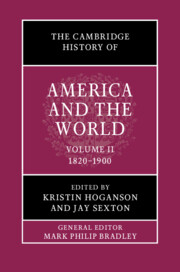Book contents
- The Cambridge History of America and the World
- The Cambridge History of America and the World
- The Cambridge History of America and the World
- Copyright page
- Contents
- Figures
- Maps
- Tables
- Contributors to Volume II
- General Introduction: What is America and the World?
- Introduction to Volume II
- Part I Building and Resisting US Empire
- Part II Imperial Structures
- Part III Americans and the World
- Part IV Americans in the World
- 23 The Changing Geography of Mobility, 1820–1940
- 24 The United States and the Greater Caribbean, 1763–1898
- 25 Borderlands and Border Crossings
- 26 The Liberal North Atlantic
- 27 “To Enter America from Africa and Africa from America” during the Nineteenth Century
- 28 Islamic World Encounters
- 29 The American Island Empire: US Expansionism in the Pacific and the Caribbean
- 30 Inter-Imperial Entanglements in the Age of Imperial Globalization
- Index
26 - The Liberal North Atlantic
from Part IV - Americans in the World
Published online by Cambridge University Press: 12 November 2021
- The Cambridge History of America and the World
- The Cambridge History of America and the World
- The Cambridge History of America and the World
- Copyright page
- Contents
- Figures
- Maps
- Tables
- Contributors to Volume II
- General Introduction: What is America and the World?
- Introduction to Volume II
- Part I Building and Resisting US Empire
- Part II Imperial Structures
- Part III Americans and the World
- Part IV Americans in the World
- 23 The Changing Geography of Mobility, 1820–1940
- 24 The United States and the Greater Caribbean, 1763–1898
- 25 Borderlands and Border Crossings
- 26 The Liberal North Atlantic
- 27 “To Enter America from Africa and Africa from America” during the Nineteenth Century
- 28 Islamic World Encounters
- 29 The American Island Empire: US Expansionism in the Pacific and the Caribbean
- 30 Inter-Imperial Entanglements in the Age of Imperial Globalization
- Index
Summary
The middle decades of the nineteenth century witnessed the creation of a liberal North Atlantic that profoundly shaped America’s role in the wider world. State-to-state interaction did less to frame the contours of this era’s liberal ascendency than the discourse of travelers, reformers, and writers whose commitments and attitudes affirmed the century’s progressive tendencies. Observations published by Europeans sojourning in the United States offered early glimpses of an emerging conviction, shared within and beyond US borders, that mankind’s liberal future would boast an American pedigree.
John Stuart Mill stated a truism in his 1840 remark that “every book of travels in America had been a party pamphlet.” But while transatlantic travelogues of the colonial, revolutionary, and post-revolutionary periods had been “pressed into the service of one party or the other,” the appearance of Democracy in America (1835; 1840) by French aristocrat Alexis de Tocqueville shifted the dialogue. Thenceforth, popular government – its desirability, its extent, and its deficiencies – would be a touchstone for foreigners’ reflecting upon the American experiment.
- Type
- Chapter
- Information
- The Cambridge History of America and the World , pp. 617 - 641Publisher: Cambridge University PressPrint publication year: 2022

